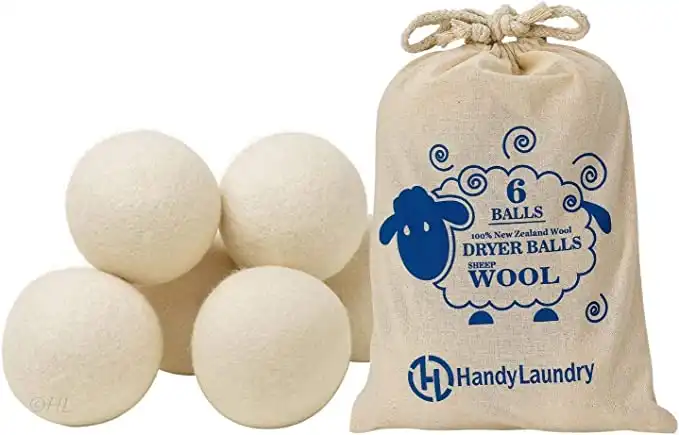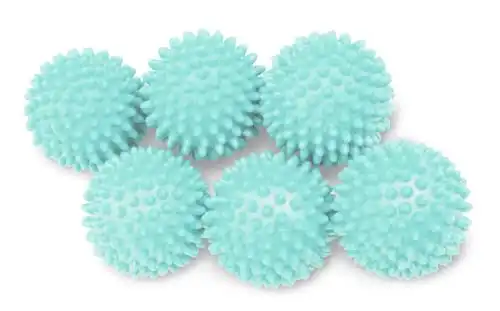- You are here:
- Home »
- Non Toxic Home Poducts »
- The Ultimate Guide to Wool vs Plastic Dryer Balls
Wool vs Plastic Dryer Balls
Dryer balls are an eco-friendly and cost-effective solution for reducing drying time, softening fabrics, and eliminating static in the laundry. They are typically made of either wool or plastic, and can be used as alternatives to traditional fabric softeners or dryer sheets.
The balls work by bouncing around inside the dryer to help separate clothes, allowing hot air to circulate more freely so that your laundry dries faster and with less energy. They also help create air pockets that reduce static cling while fluffing up fabrics.
In this article, we are going to compare plastic and wool dryer balls to help you decide which type of ball is best for you.
What Are Wool Dryer Balls?
Wool dryer balls are made from natural fibers, namely sheep’s wool. They work by separating fabrics and creating air pockets, enabling hot air to circulate more freely so that your laundry dries faster and with less energy. Additionally, the balls can help soften fabrics naturally without harsh chemicals or synthetic fragrances.
Advantages of Wool Dryer Balls
- Sustainable and eco-friendly: Wool dryer balls are natural and a renewable resource, which means they have little to no environmental impact.
- Quicker drying time: Since wool is fluffy and increases airflow in the dryer, it can reduce drying time by up to 25%!
- Softer fabric: The wool fibers help to naturally soften fabrics and keep static at bay.
Disadvantages of Wool Dryer Balls
- Higher upfront cost: Wool dryer balls are typically more expensive than traditional fabric softeners or single-use dryer sheets.
- Not as effective on large loads: Wool dryer balls struggle to effectively separate larger loads and can be less efficient compared to store-bought products.
- Accumulation of lint and grime: Over time, the wool fibers can accumulate lint and dirt from the fabrics being dried, leading to less effective results.
All-natural, healthy chemical-free organic alternative to liquid fabric softeners and dryer sheets
What Are Plastic Dryer Balls?
Plastic dryer balls are usually made from recycled PET bottles, and they work in a similar way to wool dryer balls by separating fabrics and creating air pockets to enable hot air to circulate more freely.
Plastic balls can be slightly larger than their wool counterparts, allowing them to effectively separate even large loads and reduce drying time. Additionally, some plastic dryer balls come with added features such as pet hair magnets and scented beads.
Advantages of Plastic Dryer Balls
- Lower upfront cost: Plastic dryer balls are usually cheaper than wool alternatives, making them a more affordable option
- Longer lifespan: Rather than having to replace them each time, plastic dryer balls can last up to 1000 loads, which provides great value for money.
- Quick results: Since plastic dryer balls are heavier and denser than wool options, they help to fluff up clothes faster, significantly reducing drying time.
Disadvantages of Plastic Dryer Balls
- Wear and tear: Plastic dryer balls can break down over time, resulting in chunks of plastic being shed in your laundry.
- Difficulty cleaning: Plastic dryer balls may be harder to clean due to their material and texture, which can lead to an accumulation of grime and dirt.
- Damage to fabrics: Plastic dryer balls can cause pilling on natural fibers like wool, cashmere, and cotton.
- Plastic pollution: Using plastic dryer balls contributes to the accumulation of microplastics in the environment, which can have a devastating effect on wildlife and ecosystems.
So which one is better?
Even though plastic is more affordable than wool, there are several advantages that make wool dryer balls a superior option. Here’s why:
- Reusability: Wool dryer balls are made from 100% natural sheep’s wool, so they can be reused thousands of times without showing any signs of wear or tear. This makes them more cost-effective in the long run.
- Chemical-free: Unlike plastic, wool dryer balls don’t contain any chemicals or synthetic fragrances. This helps keep your fabrics clean and safe from damaging toxins.
- Eco-friendly: Since wool dryer balls are biodegradable, they won’t contribute to the accumulation of microplastics in the environment like their plastic counterparts do. Plus, wool fibers create less lint which reduces the risk of clogged lint traps and possible fires in your home.
Overall, wool dryer balls offer more benefits than plastic ones as they’re more eco-friendly, chemical-free, and reusable. With proper care and maintenance, they can last you years while saving you money on energy costs too!
All-natural, healthy chemical-free organic alternative to liquid fabric softeners and dryer sheets
FAQs
Q: How long do wool dryer balls last?
A: Wool dryer balls can last up to 1000 loads, which is around two to five years, and they are usually more durable than plastic alternatives.
Q: Are wool dryer balls better than store-bought products?
A: Yes, wool dryer balls help to naturally soften fabrics and reduce static without the need for chemical-based softeners or fabric sheets. Moreover, they can be reused thousands of times and aren’t damaging to the environment.
Q: Are plastic dryer balls bad for the environment?
A: Since plastic dryer balls are made from recycled PET bottles, they often contain traces of toxic chemicals that could contaminate nearby water sources and harm wildlife. They also contribute to the accumulation of microplastics in the environment.
Read More: Is Laundry Detergent Toxic?
Q: Can plastic dryer balls damage fabrics?
A: Yes, plastic dryer balls can cause pilling on delicate fabrics such as wool and cashmere. Therefore, it’s best to use them with caution and avoid using them for more fragile items. Wool dryer balls are a better option for these fabric types.
Q: Do wool dryer balls work better than plastic?
A: Yes, wool dryer balls are more efficient at fluffing up clothes and can reduce drying time significantly. Plus, they help to naturally soften fabrics without any added chemicals or fragrances. Wool dryer balls also don’t cause pilling or damage to delicate fabrics like their plastic counterparts do.
Q: How to use wool dryer balls?
A: To use wool dryer balls, simply add 3-6 dryer balls to your load of laundry and run the cycle as usual. When the cycle is complete, remove the dryer balls and store them in a dry place. The more you use your dryer balls, the softer and fluffier your clothes will become!
Q: How to use plastic dryer balls?
A: To use plastic dryer balls, add 2-3 balls in a single layer to your load of laundry and run the cycle as usual. As the dryer tumbles, the balls will help separate clothes and reduce lint build-up. When the cycle is finished, remove the plastic dryer balls and store them in a cool and dry area. Make sure you clean them regularly to prevent dirt accumulation or damage to fabrics.

Conclusion
When it comes to choosing between wool and plastic dryer balls, it’s clear that the natural fibers of wool offer more benefits. Not only are wool dryer balls reusable, chemical-free, and eco-friendly, but they can also help reduce your energy costs.
Plus, they’re less likely to damage delicate fabrics like cashmere and wool. Therefore, if you’re looking for a cost-effective way to keep your laundry soft and static-free while helping the environment at the same time, then consider investing in some quality wool dryer balls!
Read More: Are Dryer Sheets Safe?
About the Author Kamila Flieger
My name is Kamila, and I'm passionate about researching non-toxic, organic products for the home. I believe it's so important to create a safe and healthy environment for our families, and I enjoy helping others do the same.



